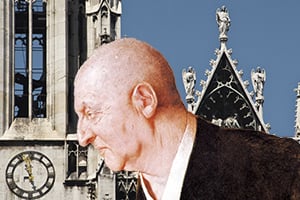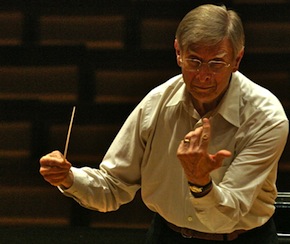
When is an hour not an hour? When you’re hearing Anton Bruckner. For the patrons of Wednesday night’s San Francisco Symphony concert in Davies Hall, entirely devoted to the composer’s massive Fifth Symphony, the subjective duration must have been as wide ranging as the music itself. By my watch, it lasted 74 minutes, but for those who walked out after the second movement at 38 minutes, or the third at 50, an hour or more must have already gone by. For those, utterly engaged, who stood and cheered at the conclusion, perhaps no time passed at all.
What is it about this symphony, that it can meddle with our internal clocks so? Why does the success of no symphony depend more than this one on the approach taken by its conductor, and why is it that whatever approach is taken cannot fail to displease some listeners?
It has often been said Bruckner built “cathedrals in sound” — and for good reason. He wrote for the glory of God. He wrote deliberately. He built with large blocks of sound, with flying buttresses of brass. He decorated his structures with repeated phrases, sequences, that take time to run their course. The listener’s job is to take it all in, let the music soak in like a sermon as the message unfolds. Artifice is eschewed; the joins in the masonry are not hidden, but are part of the design. Listeners with short attention spans requiring immediate variety cannot brook Bruckner.
The main challenges for the conductor are two, but they’re not easy, for they support the scaffolding: What tempos to use? And how to handle the joins, where the music simply stops for a bar or two, or one quiet instrument plays a few meandering lines and fades into nothingness?
High Fidelity

Herbert Blomstedt, conductor laureate of the S.F. Symphony, is no stranger to this music. He was the last person to conduct it here in 2002, a few months after he received Austria’s Anton Bruckner Prize. On Wednesday, he took on the work with fidelity to the Robert Haas edition of the score. (Bruckner never heard his own symphony, allowing conductor Franz Schalk to make significant changes not long before he died; Haas published a version closer to the original 40 years later.)
Blomstedt’s approach was direct, no nonsense, and best in the finale with the extensive contrapuntal writing, where his somewhat dry and snappy treatment paid dividends. His timings per movement were close to average among the many performances available on CD, and the Symphony players responded to his direction excellently for the most part, especially William Bennett, the oboe soloist who opened the slow movement.
But for me, Blomstedt overemphasized the many breaks in the work, rather than varying his approach to transitional emphasis. This makes the piece more a pile of blocks than an edifice. The brass attacked too sharply. The majestic chorale of the finale came roaring in as if it had a train to catch. Many conductors take it slower, despite the fact that no ritard is marked in the score. I happen to prefer the Schalk version, where the woodwinds do the initial announcing (whether this reorchestration was authorized is a matter of dispute). The pathos of the slow movement was lost during the climactic sequences of alternating, descending 7ths. Instead of cries of pain, they came across as an indifferent see-saw. By contrast, the first movement didn’t drag, and was smartly accomplished. I’m not sure what anyone could do about the two trios in the scherzo, which usually sound too repetitive unless pains are taken to contrast them. (Schalk dropped one — not that I’m totally his fan, since he also inserted ridiculous additional percussion in the finale.)
The result was a good but not great evening. With this symphony’s length, it’s difficult to add another piece without forcing a premature intermission. I’m sorry if this offends purists, but I think some gutsy composer should revise the Schalk version, which trims 10 to 15 minutes off and would allow for a full concert. Or even, since Wagner’s Ring is subject to all kinds of excerpting nowadays in concerts, perhaps just the last movement of the Fifth should be played. Or better yet, substitute Franz Schmidt’s Symphony No. 2, which concludes with a brass chorale even grander than Bruckner’s.
Still, purists and revisionists, as well as classicists and romanticists, will always be arguing about this symphony. Probably the safest thing to do, if called into court, is to take the Fifth as it is, and hope for the best.

![Bruckner Minds Cathedral Clock[2].jpg](/sites/default/files/styles/floated_content_270x/public/u19/Bruckner%20Minds%20Cathedral%20Clock%5B2%5D.jpg?itok=c0b9iAJY)